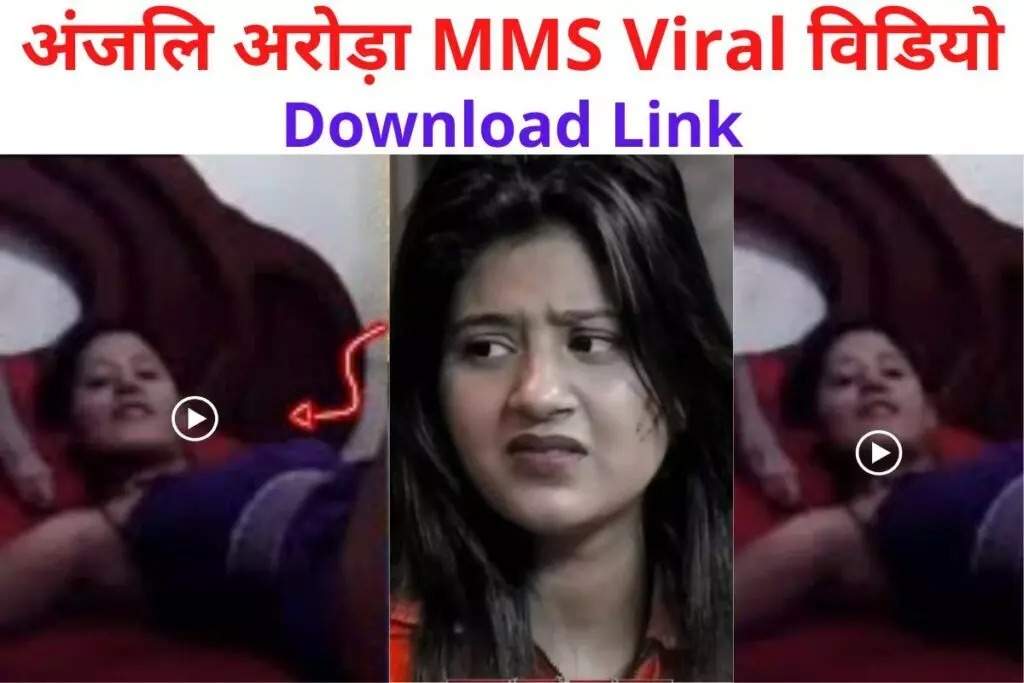In the relentless glare of the digital age, can a single viral video irrevocably define a person's life and career? The case of Anjali Arora, a prominent social media personality, brings this chilling possibility into sharp focus. Her experience serves as a stark reminder of the vulnerabilities inherent in a world where reputations can be made or broken with a single click.
The controversy surrounding Anjali Arora stems from the circulation of an alleged MMS video, purportedly featuring her in a compromising situation with DSP Nikhil Sharma. This video rapidly spread across various online platforms, sparking intense public debate and raising serious questions about its authenticity and the motivations behind its dissemination. The incident highlights the ease with which digital content, regardless of its veracity, can go viral, potentially causing irreparable damage to the individual depicted.
| Information | |
|---|---|
| Full Name | Anjali Arora |
| Occupation | Social Media Influencer, Dancer, Actress |
| Known For | Social Media Presence, Appearances in Music Videos, Reality TV Show (e.g., Lock Upp) |
| Controversy | Alleged MMS Video Leak (Subject of Legal Action) |
| Legal Actions | Defamation Case Filed Against Media Outlets and YouTube Influencers |
| Reference Website | Anjali Arora's Instagram Profile (Official Account) |
The digital footprint, once a tool for self-expression and connection, can swiftly morph into a source of profound vulnerability. For individuals in the public eye, this risk is exponentially magnified. Anjali Arora's experience is, unfortunately, not unique. Countless others have found themselves at the epicenter of similar digital storms, battling to protect their reputations and reclaim their narratives. The key element in her situation is the alleged video's content, which, if manipulated or falsely attributed, constitutes a severe breach of privacy and a potential act of defamation.
- Decoding The 50 Cent Diddy Beef A Hiphop Feud Case Study Analysis Unveiled
- Spotlight On Zoe Perrys Children The Price Amp Joy Of Fame
Following the widespread circulation of the alleged video, Anjali Arora reportedly initiated legal proceedings, filing a defamation case against numerous media outlets and YouTube personalities. These entities are accused of actively contributing to the propagation of what Arora's legal team contends is manipulated and defamatory content. The legal action underscores the seriousness with which Arora is addressing the situation and her determination to hold those responsible accountable for their actions.
The complexities surrounding the situation extend beyond the immediate impact on Anjali Arora's personal and professional life. They also raise broader questions about the responsibilities of media outlets and online influencers in the digital age. The rapid dissemination of unverified information, often driven by sensationalism and clickbait, can have devastating consequences for individuals and society as a whole. The case serves as a potent reminder of the need for greater ethical considerations and responsible reporting practices in the digital sphere.
The question of whether a public record or verifiable information exists pertaining to Anjali Arora and the alleged MMS video remains a subject of intense speculation and debate. The term "MMS video" itself refers to a multimedia message, typically sent via mobile networks, often containing visual content. In this context, the term has become synonymous with the alleged video featuring Anjali Arora. However, the authenticity of the video and its actual content remain contested. Despite extensive searches, it has proven difficult to locate definitive evidence that supports the claims made about the video's authenticity or the circumstances surrounding its creation and dissemination.
- Discover Surprising Facts About Albert Einstein A Genius Unveiled
- Unveiling Elon Musks Parents Impact Shaping A Visionary Mind
Furthermore, the origin and initial source of the video remain shrouded in mystery. Identifying the individual or group responsible for releasing the video is crucial to understanding the motivations behind its circulation and to potentially uncovering any malicious intent. The lack of transparency surrounding the video's origins contributes to the ongoing speculation and makes it difficult to verify the accuracy of the claims made about its content and its connection to Anjali Arora.
The case of Anjali Arora also highlights the potential for online content to be manipulated or fabricated. Deepfake technology, for example, has made it increasingly easy to create realistic but entirely fictitious videos that can be used to defame or harass individuals. While there is no concrete evidence to suggest that the alleged video featuring Anjali Arora is a deepfake, the possibility remains a concern given the ease with which such manipulations can be carried out. This raises questions about the need for greater technological safeguards to protect individuals from the potential misuse of their likeness in online content.
The situation also underscores the importance of critical thinking and media literacy in the digital age. Individuals should be encouraged to question the authenticity of online content and to avoid blindly sharing information that has not been verified. Social media platforms and search engines also have a responsibility to combat the spread of misinformation and to promote accurate and reliable information. This requires a multi-faceted approach that includes fact-checking, content moderation, and the promotion of media literacy education.
In addition to the legal and reputational challenges, Anjali Arora has likely faced significant emotional distress as a result of the circulation of the alleged video. The experience of being targeted by online harassment and defamation can have a profound impact on mental health and well-being. It is important to recognize the psychological toll that such experiences can take and to provide support to individuals who have been victimized by online abuse.
The incident involving Anjali Arora serves as a cautionary tale for anyone who maintains a public profile online. It highlights the need to be vigilant about protecting one's privacy and reputation in the digital age. This includes taking steps to secure online accounts, being mindful of the content that is shared online, and seeking legal counsel if one becomes the target of online harassment or defamation.
The legal action taken by Anjali Arora against media outlets and YouTube influencers represents a significant step in holding those responsible for the spread of the alleged video accountable. The outcome of this legal case will have important implications for the future of online defamation law and the responsibilities of media outlets and online platforms in the digital age. It will also serve as a test case for the ability of individuals to protect their reputations in the face of online attacks.
The case also raises questions about the role of social media platforms in policing online content. While these platforms have taken steps to combat the spread of misinformation and harmful content, more needs to be done to protect individuals from online harassment and defamation. This includes developing more effective content moderation policies, providing users with better tools to report abuse, and working with law enforcement to identify and prosecute those who engage in online harassment.
The address "22 jinxiu east road,kengzi street,pingshan district,shenzhen city,p.r." and "84249 buford crossroad, kerluke overpass 241, north berthaborough, 47983, germany" mentioned in the search results appear to be unrelated to the Anjali Arora controversy. These addresses may be associated with other online searches or unrelated topics. Similarly, the phrases "Gm mode hosting providers news about forum suggestions wiki lore patches" and "18++ video completo video de melao ricura escandalo viral watch asesinato de val 0people involved:" are likely the results of unrelated search queries and do not appear to have any direct connection to the Anjali Arora case.
It is important to avoid drawing any unwarranted conclusions or making unsubstantiated connections between these unrelated search results and the Anjali Arora controversy. Doing so could contribute to the spread of misinformation and further exacerbate the harm that has already been caused by the circulation of the alleged video.
In conclusion, the case of Anjali Arora serves as a stark reminder of the challenges and vulnerabilities that exist in the digital age. The circulation of the alleged MMS video has had a profound impact on her personal and professional life, and it raises important questions about the responsibilities of media outlets, online platforms, and individuals in the digital sphere. The legal action taken by Anjali Arora represents a significant step in holding those responsible for the spread of the video accountable, and it will have important implications for the future of online defamation law. The case also underscores the need for greater media literacy, critical thinking, and online safety measures to protect individuals from the potential harms of the digital age.
The experience also brings to light the pervasive issue of victim blaming that often accompanies such controversies. Instead of focusing on the alleged actions of the individual in the video, the conversation often shifts to scrutinizing and judging the victim. This not only perpetuates harmful stereotypes but also discourages victims of online harassment and defamation from coming forward and seeking help. A more compassionate and empathetic approach is needed to address these issues effectively.
Furthermore, the incident highlights the urgent need for comprehensive digital literacy education. Individuals need to be equipped with the skills to navigate the online world safely and responsibly, including the ability to identify misinformation, protect their privacy, and report online abuse. This education should begin at a young age and continue throughout life to ensure that everyone can participate fully and safely in the digital age.
The case of Anjali Arora also raises important questions about the long-term consequences of online shaming and harassment. The digital record is permanent, and content that is posted online can remain accessible for years to come. This means that individuals who have been targeted by online abuse may continue to suffer the consequences of those actions long after the initial incident has faded from public memory. This underscores the need for effective strategies to mitigate the long-term impact of online shaming and harassment.
In addition to legal remedies, psychological support and counseling can play a crucial role in helping individuals recover from the trauma of online harassment and defamation. Mental health professionals can provide guidance and support to help victims cope with the emotional distress they have experienced and develop strategies for rebuilding their lives. It is important to ensure that these services are accessible and affordable to those who need them.
The case of Anjali Arora also underscores the need for greater collaboration between law enforcement, social media platforms, and other stakeholders to combat online harassment and defamation. This includes developing more effective methods for identifying and prosecuting those who engage in online abuse, as well as creating more robust mechanisms for removing harmful content from the internet. A coordinated and collaborative approach is essential to creating a safer and more respectful online environment.
Ultimately, the case of Anjali Arora serves as a call to action for all members of society to take responsibility for creating a more ethical and compassionate online world. This requires a commitment to critical thinking, responsible reporting, and respectful communication. It also requires a willingness to challenge harmful stereotypes and to support those who have been victimized by online abuse. By working together, we can create a digital environment that is safer, more equitable, and more conducive to human flourishing. The incident surrounding Anjali Arora, while deeply unfortunate, presents an opportunity to learn from our mistakes and to build a better future for all in the digital age.
The narrative surrounding Anjali Arora and the alleged MMS video also shines a light on the gendered nature of online harassment. Women are disproportionately targeted by online abuse, and the content of that abuse often focuses on their sexuality and physical appearance. This reflects broader societal inequalities and reinforces harmful stereotypes about women. Addressing this issue requires a concerted effort to challenge these stereotypes and to promote gender equality in all aspects of life, both online and offline.
Furthermore, the case highlights the power of collective action in combating online harassment. When individuals and groups come together to support victims of online abuse and to challenge the perpetrators, they can create a powerful force for change. This can include organizing online campaigns, signing petitions, and raising awareness about the issue through social media and other channels. Collective action can send a strong message that online harassment is not acceptable and that those who engage in it will be held accountable.
The legal proceedings initiated by Anjali Arora also raise important questions about the burden of proof in online defamation cases. It can be difficult to prove that online content is defamatory, particularly when it involves allegations that are difficult to verify. This can make it challenging for victims of online abuse to obtain legal redress. There is a need for a re-evaluation of the legal standards for online defamation to ensure that victims are able to protect their reputations effectively.
In addition to legal and psychological remedies, restorative justice approaches may also be helpful in addressing online harassment. Restorative justice involves bringing together the victim and the perpetrator of the abuse to discuss the harm that has been caused and to develop a plan for repairing the damage. This approach can be particularly effective in cases where the perpetrator is willing to take responsibility for their actions and to make amends to the victim. While restorative justice may not be appropriate in all cases of online harassment, it can be a valuable tool for promoting healing and reconciliation.
The case of Anjali Arora also underscores the need for greater transparency and accountability on social media platforms. These platforms have a responsibility to provide users with information about how their content moderation policies are implemented and to be transparent about the criteria that are used to remove content from the site. This transparency is essential to ensuring that content moderation decisions are fair and consistent and that users are able to understand why their content has been removed.
Ultimately, addressing the challenges of online harassment and defamation requires a holistic approach that involves legal reforms, technological solutions, educational initiatives, and cultural changes. It is a complex and multifaceted problem that cannot be solved by any single solution. By working together, we can create a digital environment that is safer, more respectful, and more conducive to human flourishing. The experience of Anjali Arora, while deeply unfortunate, can serve as a catalyst for positive change and a reminder of the importance of creating a more just and equitable online world.
- Decoding Blackpink All About Blackpink Members Their Influence
- Exploring Vegamivie Nl Your Guide To Vegan Products In The Netherlands


